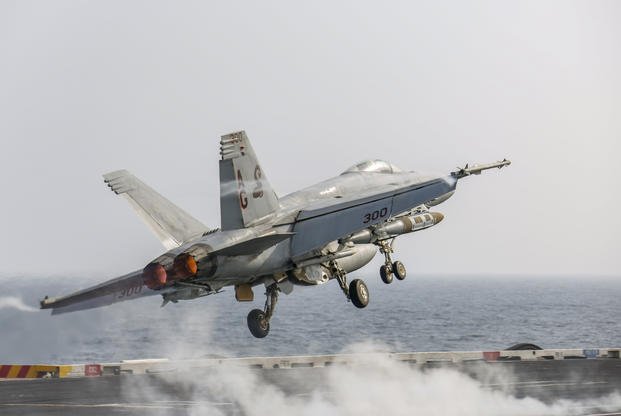The U.S. Navy has met former Defense Secretary Jim Mattis's 80% mission-capable rate goal for its major operational aircraft fleet, officials announced Tuesday.
Officials said F/A-18 E/F Super Hornet and EA-18G Growler fleets each "stand above" the goal, with 343 primary mission aircraft inventory (PMAI) F-18 jets and 95 PMAI Growler aircraft ready to deploy at a moment's notice.
"This has been a year of results for Naval aviation," said Vice Adm. DeWolfe H. Miller, the head of the Naval Air Force, in a release. Miller attributed the rise in mission-capable rates to the work of the Naval Aviation Enterprise's Naval Sustainment System-Aviation program.
"I am incredibly proud of our sailors, civilian teammates and industry partners," he said.
After nearly a decade of "regularly maintaining between 250-260 [mission-capable] F/A-18s, the Navy is now sustaining over 320 MC Super Hornets and surged to attain service goals of 341 MC Super Hornet and 93 MC Growler aircraft this month," the release said.
"They developed and implemented the [Naval Sustainment System] and then drove readiness numbers that haven't been seen in over a decade," Miller said. "Their results are incredible and their passion for improvement is inspirational."
As of 2015, the Navy had 545 F/A-18E/F models in the inventory, but it's unclear how many of those are part of the primary mission aircraft inventory.
Related: Mattis Orders Supercharge in Fighter Jet Readiness
In 2018, then-SecDef Mattis said the services must achieve a minimum level of 80% readiness for the F-16 Fighting Falcon, F-22 Raptor, F-35 Joint Strike Fighter and F/A-18 Hornet fleets by the end of fiscal 2019. The end of the fiscal year is days away, on Sept. 30.
The Navy said it included the Growler in its sustainment work because of its similarity to the Hornet.
During a panel discussion hosted by the Center for Strategic and International Studies in October 2018, Miller said the service's F/A-18 fleet was at a mission-capable rate of roughly 50%, with about 260 aircraft ready to deploy. Miller at the time explained that the Navy must increase that number to at least 341 in order to hit the 80% goal, and needed the help of the sustainment system to do so.
The NSS program also brought in additional experts to watch how maintainers perform.
"What's different this time is the expertise of the outside industry that we're bringing in," Miller said during the panel. "This is supported at the highest levels of the [Defense] Department, and that gives me confidence that if we ... require changes in policy or law, that we will have complete support moving forward. This ... is a proven system" in the civilian airline industry.
"It is going to leverage the best practices from commercial industries," Miller said.
The Navy began looking to its fleet readiness centers and depot supply chain to spearhead the effort, starting with the Super Hornet lines. Experts were brought in to tour fleet readiness centers, working with Navy counterparts on where they see inefficiencies in the system.
Rear Adm. Roy Kelley, commander of Naval Air Forces-Atlantic, said flight hours for the fleets have also increased.
"This is the first year in some time that we have executed our allocation of flight hours completely," Kelley said in the release. "That stands as a sign of health that we have a lot of 'up' aircraft, and that the parts are moving. We're getting healthy and we're on the right track."
The Navy officials said maintenance sustainment for the fleets will continue in order to keep the older fleets as ready as possible.
The Navy did not mention its readiness numbers for its F-35 Joint Strike Fighter variants -- the Navy C-model and Marine Corps B-model -- even though the Pentagon included the JSF fleet in the supercharged readiness plan.
Vice Adm. Mat Winter, the F-35 program executive officer, told lawmakers in April those F-35 variants were still on track to meet the target even though both services have limited quantities in comparison to the Air Force, according to a report from USNI News.
Earlier this month, Air Force officials acknowledged that the service wouldn't meet the Pentagon's goal of boosting readiness across its fighter fleets before the fiscal year comes to a close.
Lt. Gen. Mark Kelly, deputy chief of staff for operations, told audiences at the 2019 Defense News Conference that only one airframe would make the goal.
"The F-16 MC rate in our active-duty units is above 80%," Kelly said during a panel on Air Force prioritization. The service has 941 of the fourth-generation fighter in its inventory.
The F-22 Raptor and F-35A Lightning II fleets will come up short, he said, but for different reasons.
The F-22's low-observable skin, which makes it stealthy, has been demanding to maintain, he said. The F-35, meanwhile, has seen greater operational use even as bases are still activating F-35 squadrons. The Air Force recently deployed a contingent of F-35s to the Middle East for the first time.
"We learned a lot from the [mission-capable] effort," Kelly said, explaining it would be easy to achieve an 80% mission-capable rate for its jets if only the Air Force would stop flying altogether.
"But we didn't do that during that time frame; we actually flew more. We've flown more every year since 2017 to give aviators more experience and have them more ready," he said.
-- Oriana Pawlyk can be reached at oriana.pawlyk@military.com. Follow her on Twitter at @oriana0214.
Read More: Elite Air Force Rescue Squadron Commander Relieved Over 'Loss of Confidence'













